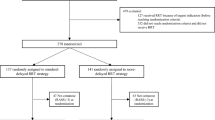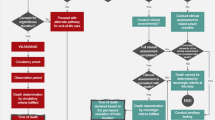Abstract
In order to examine renal function after brain death, twenty-eight patients were randomly separated into two groups. The systemic blood pressure of ten patients was maintained with epinephrine alone (group 1). Eight of the ten patients experienced cardiac arrest within 48 h (range 6–87 h) despite the rather large dosage of epinephrine. Urine output was uncontrollable and renal function deteriorated progressively in this group. Eighteen patients were maintained with arginine vasopressin and epinephrine (group 2). Circulation was maintained with a smaller dosage of epinephrine than that given group 1 for at least 4 days (mean±SD 16.5±12.2 days). Urine output was controlled within the normal range and serum levels of blood urea nitrogen (BUN) and creatinine were normal for 14 days. Daily creatinine clearance was more than 80 ml/min. The combined administration of arginine vasopressin and epinephrine preserved the kidneys after brain death for more than a week. This method will be of great value in renal transplantation from brain-dead organ donors.
Similar content being viewed by others
References
Aviado DM, Wnuck AL, DeBeer EJ (1958) The effects of sympathomimetic drugs on renal vessels. J Pharmacol Exp Ther 12: 238–244
Barber J, Becker D, Behrman R et al. (1981) Guidelines for the determination of death. JAMA 246: 2184–2186
Brown AJ, Lohmeier TE, Carroll RG, Meydrech EF (1986) Cardiovascular and renal responses to chronic vasopressin infusion. Am J Physiol 250: H584-H594
Carrol RPN, Chisholm GD, Shackman R (1969) Factors influencing early function of cadaver renal transplants. Lancet II: 551–552
Dalgaad OZ (1960) An electron microscopic study on glomeruli in renal biopsies taken from human shock kidney. Lab Invest 9: 364–366
Darmady EM (1957) The renal change in anuria following medical conditions. Proc R Soc Med 50: 498–500
Dhabuwala CB, Bird M, Salaman JR (1979) Relative importance of warm ischemia, hypotension, and hypercarbia in producing renal vasospasm. Transplantation 27: 238–241
Green RD, Boyer D, Halasz NA, Collins GM (1979) Pharmacological protection of rabbit kidneys from normothermic ischemia. Transplantation 28: 131–134
Hofbauer KG, Dienemann H, Forgiarini P, Stalder R, Wood JM (1983) Renal vascular effects of angiotensin. II. Arginine-vasopressin and bradykinin in rats: interactions with prostaglandins. Gen Pharmacol 14: 145–147
Liard JF, Deriaz O, Schelling P, Thibonnier M (1982) Cardiac output distribution during vasopressin infusion or dehydration in conscious dogs. Am J Physiol 243: H663-H669
Nagareda T, Kinoshita Y, Tanaka A, Hasuike Y, Terada N, Nishizawa Y, Fujita M, Kuroda H, Yahata K, Aozasa K, Sakano T, Sugimoto T, Kotoh K (1989) Clinicopathological study of livers from brain-dead patients treated with a combination of vasopressin and epinephrine. Transplantation 47: 792–797
Oliver J, MacDowell M, Tracy A (1951) The pathogenesis of acute renal failure associated with traumatic and toxic injury: renal ischemia, nephrotoxic damage and ischemuric episode. J Clin Invest 30: 1307–1440
Raftery AT, Johnson RWG (1979) Dopamine pretreatment in unstable kidney donors. Br Med J 24: 522
Royal Colleges and Faculties in the United Kingdom (1976) Diagnosis of brain death. Br Med J 2: 1187–1188
Sato Y, Matsuzawa H, Eguchi S (1982) Comparative study of effects of adrenaline, dobutamine and dopamine on systemic hemodynamics and renal blood flow in patients following open heart surgery. Jpn Circ J 46: 1059–1072
Schmid PG, Abboud FM, Wendliing MG, Ramberg ES, Mark AL, Heistad DD, Eckstein JW (1974) Regional vascular effects of vasopressin: plasma levels and circulatory responses. Am J Physiol 227: 998–1004
Schneider A, Toledo-Pereyra LH, Zeichner WD, Allaben R, Whitten J (1983) Effect of dopamine and pitressin on kidneys procured and harvested for transplantation. Transplantation 36: 110–111
Smith MJ, Cowley AW, Guyton AC, Manning RD (1979) Acute and chronic effects of vasopressin on blood pressure, electrolytes, and fluid volumes. Am J Physiol 237: F232-F240
Sugimoto T, Sadamitsu D, Sawada Y (1985) Criteria for the diagnosis of brain death: report of the committee for investigation of brain death in Osaka University, School of Medicine. Med J Osaka Univ 36: 29–34
Yoshioka T, Sugimoto H, Uenishi M, Sakamoto T, Sadamitsu D, Sakano T, Sugimoto T (1986) Prolonged hemodynamic maintenance by the combined administration of vasopressin and epinephrine in brain death: a clinical study. Neurosurgery 18: 565–567
Author information
Authors and Affiliations
About this article
Cite this article
Kinoshita, Y., Yahata, K., Yoshioka, T. et al. Long-term renal preservation after brain death maintained with vasopressin and epinephrine. Transplant Int 3, 15–18 (1990). https://doi.org/10.1007/BF00333196
Received:
Revised:
Accepted:
Issue Date:
DOI: https://doi.org/10.1007/BF00333196




